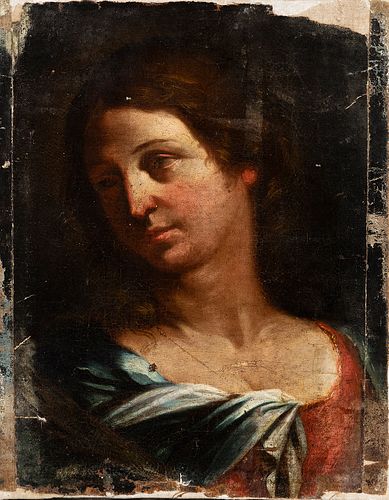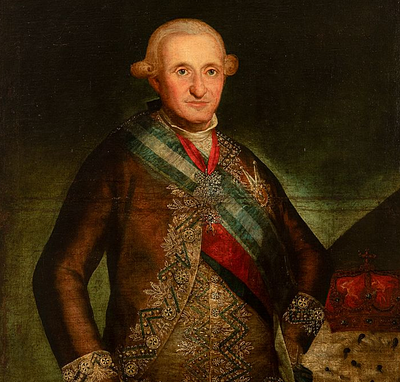Circle of GIOVANNI FRANCESCO BARBIERI "IL GUERCINO" (Italy, 1591-1666) "Saint". Oil on canvas. Relined.
Lot 14
About Seller
Setdart Auction House
Carrer Aragó 346
Barcelona
Spain
Setdart Subastas was born in 2004 and is currently the first online art auction in Spain with solidity, prestige and reliability guaranteed by our more than 60,000 users. Setdart has a young, dynamic and enterprising team ready to successfully manage the purchase and sale of art works through custom...Read more
Estimate:
EUR€3,000 - EUR€4,000
$3,125 - $4,166.67
Absentee vs Live bid
Two ways to bid:
- Leave a max absentee bid and the platform will bid on your behalf up to your maximum bid during the live auction.
- Bid live during the auction and your bids will be submitted real-time to the auctioneer.
Bid Increments
| Price | Bid Increment |
|---|---|
| EUR€0 | EUR€10 |
| EUR€200 | EUR€25 |
| EUR€500 | EUR€50 |
| EUR€1,000 | EUR€100 |
| EUR€3,000 | EUR€200 |
| EUR€5,000 | EUR€500 |
| EUR€10,000 | EUR€1,000 |
| EUR€20,000 | EUR€2,000 |
| EUR€50,000 | EUR€5,000 |
About Auction
By Setdart Auction House
Sep 22, 2021
Set Reminder
2021-09-22 09:30:00
2021-09-22 09:30:00
America/New_York
Bidsquare
Bidsquare : 22nd September - ARAS JÁUREGUI Private Collection - Old Masters, 19th & 20th Century
https://www.bidsquare.com/auctions/setdart-auction-house/22nd-september---aras-j-uregui-private-collection---old-masters-19th-20th-century-7427
ARAS JÁUREGUI Private Collection - Old Masters, 19th & 20th Century Setdart Auction House sofia@setdart.com
ARAS JÁUREGUI Private Collection - Old Masters, 19th & 20th Century Setdart Auction House sofia@setdart.com
- Lot Description
Circle of GIOVANNI FRANCESCO BARBIERI "IL GUERCINO" (Italy, 1591-1666) "Saint". Oil on canvas. Relined. It presents faults and additions on the sides. Measurements: 48 x 38 cm. In spite of the few iconographic references that exist in this female portrait, due to the features of the woman, the clothes, and even the position of her face, it is very probable that it is a religious representation. Probably a martyr saint, or even a fragment of the Good Samaritan woman. A character described in the Bible by Saint John (4: 4-26) and which has a long tradition in art, due to the text's allusions to water as "Divine Grace" or "Living Water", due to the veiled allusion to preaching and evangelisation in the text. The work has similarities with the aesthetic circle of Guercino, who was one of the most acclaimed Italian artists of the first half of the 17th century. He was born in the village of Cento in the province of Ferrara. The principal influences that shaped his style were the Bolognese Ludovico Carracci, his cousin Hannibal Carracci and the Ferrara-born Ippolito Scarsella. Apart from a two-year stay in Rome during the papacy of the Bolognese Gregorio XV Ludovisi, he was active in his native town until 1642 when he moved to neighbouring Bologna. He was about twenty-five years old when he came to the attention of his first important clients, among them Cardinal Alessandro Ludovisi, Archbishop of Bologna; Cardinal Jacopo Serra, papal legate in Ferrara; Grand Duke Cosimo II of Tuscany and Duke Ferdinand Gonzaga of Mantua. By the mid-1620s he had turned down invitations to work outside Italy, from Charles I of England among others. He seems to have been reluctant to enter into direct competition with his Bolognese rivals, especially Guido Reni, who from around 1610 was the most celebrated painter in Italy. Most of his abundant output consists of altarpieces and easel paintings, but in the first half of his career he also painted frescoes in Cento, Bologna, Rome (the Aurora on the ceiling of the Casino Ludovisi) and the cathedral of Piacenza (1626-1627). His early "Tenebrist" style is characterised by dramatic lighting, saturated colours and agitated compositions. His stay in Rome led him to gradually modify his style towards a much more idealised and classical language, with calmer and more structured compositions, more elegant contours, a generally lighter palette and richer pastel tones.
- Shipping Info
-
In-house shipping available. Please inquire at admin@setdart.com.
-
- Buyer's Premium



 EUR
EUR CAD
CAD AUD
AUD GBP
GBP MXN
MXN HKD
HKD CNY
CNY MYR
MYR SEK
SEK SGD
SGD CHF
CHF THB
THB
















